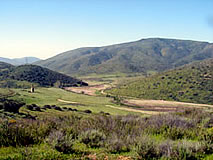San Diego Supervisors move forward but weaken General Plan
Resisting pressure from landowners, the County Board of Supervisors refused to abandon a progressive General Plan, but disappointingly also directed staff to compromise the plan by adding dozens of last minute map changes and by revising policies that would have protected plan integrity over time.

The momentous General Plan Update, 13 years in the making, underwent a series of Board hearings during the fall of 2010 through this spring. A well organized campaign financed by real estate interests vigorously attacked the underlying goal of reducing densities in farm and habitat areas as a counterpoint to focusing growth in towns – and thereby saving money on infrastructure and services and reducing fire hazard. With the Building Industry Association, Chamber of Commerce, and Farm Bureau switching to opposition mode, community, civic, and environmental groups were the remaining supporters.
Given the acknowledged legal deficiencies of the current General Plan, and wanting to achieve closure, the Board drew a line in the sand by declining to make revisions so major as to trigger the cost and delay of a new environmental impact report (EIR). However, the land use map that became the starting point for decision-making was already a compromise between a rigorous application of planning principles and a landowner “wish list” of greater development potential on individual parcels. Staff had created this hybrid in a well intentioned but unsuccessful effort to build consensus.
After staff opened the door to additional, last minute landowner requests by misclassifying dozens of these as “minor” and therefore not triggering a new EIR, the Supervisors increased densities over thousands of acres of habitat and farmlands. In doing so, the Board did not apply the planning rules uniformly, but rather favored a subset of landowners – those who complained – over the rest, who accepted the results of good planning. The San Diego Union-Tribune had editorialized against what it accurately termed “line item zoning.” However, if staff had not properly classified hundreds other requests as so major as to trigger a new EIR, the plan could well have been dismantled.
Also, the Supervisors welcomed future piecemeal amendment to the plan by removing a policy that would have required major land use changes to be part of a more comprehensive evaluation. Several sprawl projects that could "bust open" the plan are now waiting in the wings. On the positive side, the Conservation Subdivision Program, for consolidating development in order to protect natural resources, moved forward, as did a pilot project for purchasing agricultural conservation easements.
During these hectic months, EHL worked intensively. We met with Board Members, attempted to find common ground with the building industry, organized support from activists, communicated with community groups, and submitted a series of detailed comment letters that analyzed the legal issues before the Board and the compliance of the landowners’ requests with the guiding principles of the Update.
The Update was designed to stop the mad consumption by estate lots and ranchettes of what remains of the San Diego countryside and to refocus growth in towns. After final action – anticipated for this summer – EHL will carefully assess how much of the original vision remains.


